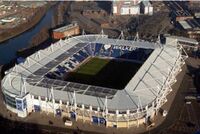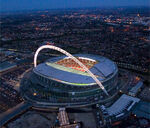(Created page with "{{stadium-stub}} {{Stadium images needed}} {{Infobox Stadium | nickname = | image = | caption = | full_name = | owners = | location = | broke_ground = | built = | open...") |
No edit summary Tag: sourceedit |
||
| (7 intermediate revisions by 2 users not shown) | |||
| Line 1: | Line 1: | ||
| + | {{Tabs |
||
| − | {{stadium-stub}} |
||
| + | |backcolor=#FFE93E |
||
| − | {{Stadium images needed}} |
||
| + | |altbackcolor=#FFFFFF |
||
| + | |bordercolor=silver |
||
| + | |borderradius=6 |
||
| + | |height=2.2 |
||
| + | |maxwidth=20 |
||
| + | |tab1=General |
||
| + | |tab2=Image gallery |
||
| + | }} |
||
{{Infobox Stadium |
{{Infobox Stadium |
||
| − | | nickname = |
+ | | nickname = Filbert Way |
| − | | image = |
+ | | image = [[File:King Power Stadium.jpg|200px]] |
| caption = |
| caption = |
||
| − | | full_name = |
+ | | full_name = King Power Stadium |
| − | | owners = |
+ | | owners = K Power Holdings Co Ltd |
| − | | location = |
+ | | location = Filbert Way, Leicester, England |
| broke_ground = |
| broke_ground = |
||
| − | | built = |
+ | | built = 2002 |
| − | | opened = |
+ | | opened = 2002 |
| renovated = |
| renovated = |
||
| expanded = |
| expanded = |
||
| Line 16: | Line 24: | ||
| demolished = |
| demolished = |
||
| tenants = [[Leicester City F.C.|Leicester City]] {{small|(2002–present)}} |
| tenants = [[Leicester City F.C.|Leicester City]] {{small|(2002–present)}} |
||
| − | | seating_capacity = |
+ | | seating_capacity = 32,262 |
| − | | dimensions = |
+ | | dimensions = 102 x 67 metres |
| − | | record_attendance = |
+ | | record_attendance = 32,488 |
|}} |
|}} |
||
| + | The '''King Power Stadium''' is a [[association football|football]] stadium which hosts home matches of English football club [[Leicester City F.C.|Leicester City]], currently playing in the [[Premier League]]. The all-seater stadium, inaugurated in July 2002, has a capacity of 32,262 and is the 19th largest stadium capacity in England. The stadium is named after King Power, a company owned by club owner [[Vichai Raksriaksorn]]. |
||
| + | ==History== |
||
| + | ===Background and construction=== |
||
| + | Leicester's previous stadium was at nearby [[Filbert Street]], which had been their home since 1891. It was gradually upgraded during the 20th century and with the advent of the Taylor Report in January 1990 requiring all clubs in the top two divisions to have all-seater stadiums by August 1994, Leicester City's directors began to investigate the possibility of building a new stadium during the early 1990s, but initially decided to take the redevelopment option by building a new stand on one side of Filbert Street and fitting seats into the remaining standing areas, giving the stadium a 21,500 all-seated capacity by the [[1994-95 in English football|1994–95 season]]. |
||
| + | Filbert Street's conversion to an all-seater stadium coincided with their promotion to the [[Premier League]] after a seven-year exile from the top flight, and with their relegation after just one season it appeared that the 21,500 capacity would be adequate. |
||
| ⚫ | |||
| + | However, success in the late 1990s saw crowds rise, which meant that virtually every game at Filbert Street was a sell-out by the end of the decade. Relocation was soon back on the cards; several similar sized clubs had relocated to new stadiums around this time, including Leicester's midland rivals [[Stoke City F.C.|Stoke City]] and [[Derby County F.C.|Derby County]]. |
||
| + | |||
| + | Some parts of the ground – the East and North Stands in particular – were also somewhat outdated, which led the manager, [[Martin O'Neill]] to joke that when he showed Filbert Street to new signings he led them backwards out of the players tunnel to prevent them from seeing the East Stand. |
||
| + | |||
| + | In early 1998, plans were announced for a 40,000 all-seater stadium to be built at Bede Island South in time for the [[2000-01 in English football|2000–01 season]], but these plans were abandoned on 5 January 2000. Chairman [[John Elsom]] vowed that other options, including relocation to another site or even further redevelopment of Filbert Street, would be considered, hoping that either option would have materialised by August 2002. |
||
| + | |||
| + | The relocation option was soon settled upon, as plans were unveiled on 2 November 2000 for a 32,000-seat stadium at nearby Freeman's Wharf, with [[2003-04 in English football|2003–04]] being the expected completion date, although it was suggested at the time relocation could happen at the start of the [[2002-03 in English football|2002–03 season]]. |
||
| + | |||
| + | The stadium was completed on time in the summer of 2002, ready for Leicester to take up residence for the start of the [[2002–03 in English football|2002–03]] season. However, it was not an easy start at their new stadium as they had just been relegated from the Premier League and were more than £30 million in debt. |
||
| + | |||
| + | The stadium also has under-soil heating. |
||
| + | |||
| + | The record attendance for football is 32,242 for Leicester City against [[Sunderland A.F.C.|Sunderland]] for the first game of the [[2015–16 Premier League]] season. The overall record attendance is 32,488 for a rugby union match between Leicester Tigers and Bath in 2006. This is because this rugby match took place prior to seats being removed to provide segregation of rival football fans, reducing the capacity of the ground from exactly 32,500 to 32,262. |
||
| + | |||
| ⚫ | |||
| + | *[http://www.thewalkersstadium.co.uk Official website] |
||
{{Leicester City F.C.}} |
{{Leicester City F.C.}} |
||
| − | {{ |
+ | {{Premier League stadiums}} |
| + | {{England}} |
||
[[Category:Leicester City F.C.]] |
[[Category:Leicester City F.C.]] |
||
[[Category:Stadiums]] |
[[Category:Stadiums]] |
||
[[Category:English stadiums]] |
[[Category:English stadiums]] |
||
| − | [[Category: |
+ | [[Category:Premier League stadiums]] |
Revision as of 18:41, 1 July 2016
| General |
| King Power Stadium | ||
| Filbert Way | ||

| ||
| Full name | King Power Stadium | |
| Owners | K Power Holdings Co Ltd | |
| Location | Filbert Way, Leicester, England | |
| Built | 2002 | |
| Opened | 2002 | |
| Tenants | Leicester City (2002–present) | |
| Capacity | 32,262 | |
| Field dimensions | 102 x 67 metres | |
| Highest attendance | 32,488 | |
The King Power Stadium is a football stadium which hosts home matches of English football club Leicester City, currently playing in the Premier League. The all-seater stadium, inaugurated in July 2002, has a capacity of 32,262 and is the 19th largest stadium capacity in England. The stadium is named after King Power, a company owned by club owner Vichai Raksriaksorn.
History
Background and construction
Leicester's previous stadium was at nearby Filbert Street, which had been their home since 1891. It was gradually upgraded during the 20th century and with the advent of the Taylor Report in January 1990 requiring all clubs in the top two divisions to have all-seater stadiums by August 1994, Leicester City's directors began to investigate the possibility of building a new stadium during the early 1990s, but initially decided to take the redevelopment option by building a new stand on one side of Filbert Street and fitting seats into the remaining standing areas, giving the stadium a 21,500 all-seated capacity by the 1994–95 season.
Filbert Street's conversion to an all-seater stadium coincided with their promotion to the Premier League after a seven-year exile from the top flight, and with their relegation after just one season it appeared that the 21,500 capacity would be adequate.
However, success in the late 1990s saw crowds rise, which meant that virtually every game at Filbert Street was a sell-out by the end of the decade. Relocation was soon back on the cards; several similar sized clubs had relocated to new stadiums around this time, including Leicester's midland rivals Stoke City and Derby County.
Some parts of the ground – the East and North Stands in particular – were also somewhat outdated, which led the manager, Martin O'Neill to joke that when he showed Filbert Street to new signings he led them backwards out of the players tunnel to prevent them from seeing the East Stand.
In early 1998, plans were announced for a 40,000 all-seater stadium to be built at Bede Island South in time for the 2000–01 season, but these plans were abandoned on 5 January 2000. Chairman John Elsom vowed that other options, including relocation to another site or even further redevelopment of Filbert Street, would be considered, hoping that either option would have materialised by August 2002.
The relocation option was soon settled upon, as plans were unveiled on 2 November 2000 for a 32,000-seat stadium at nearby Freeman's Wharf, with 2003–04 being the expected completion date, although it was suggested at the time relocation could happen at the start of the 2002–03 season.
The stadium was completed on time in the summer of 2002, ready for Leicester to take up residence for the start of the 2002–03 season. However, it was not an easy start at their new stadium as they had just been relegated from the Premier League and were more than £30 million in debt.
The stadium also has under-soil heating.
The record attendance for football is 32,242 for Leicester City against Sunderland for the first game of the 2015–16 Premier League season. The overall record attendance is 32,488 for a rugby union match between Leicester Tigers and Bath in 2006. This is because this rugby match took place prior to seats being removed to provide segregation of rival football fans, reducing the capacity of the ground from exactly 32,500 to 32,262.
External links
|
Current season •
Club honours •
Managers •
Players •
Squads •
Ladies •
King Power Stadium |




